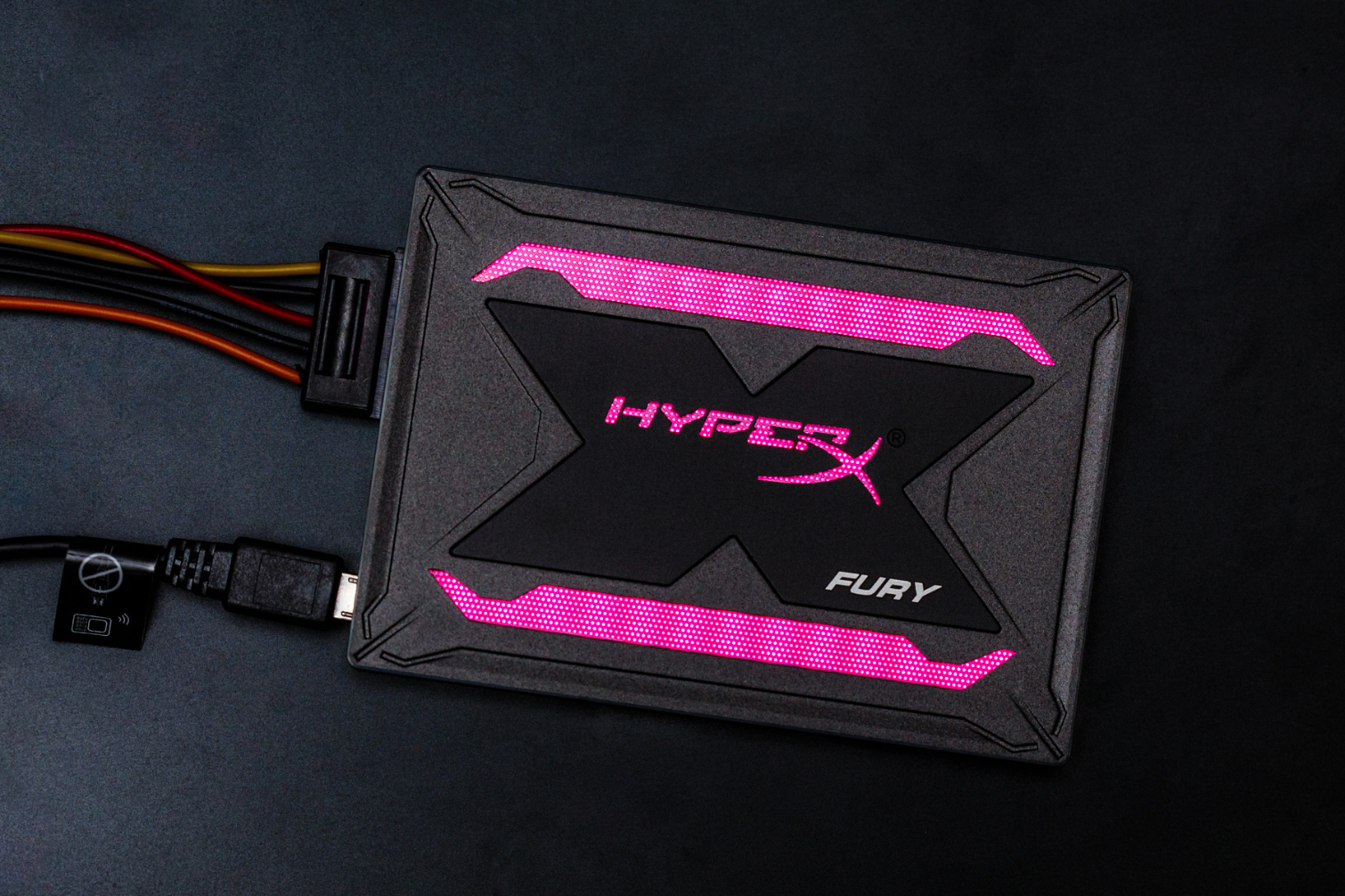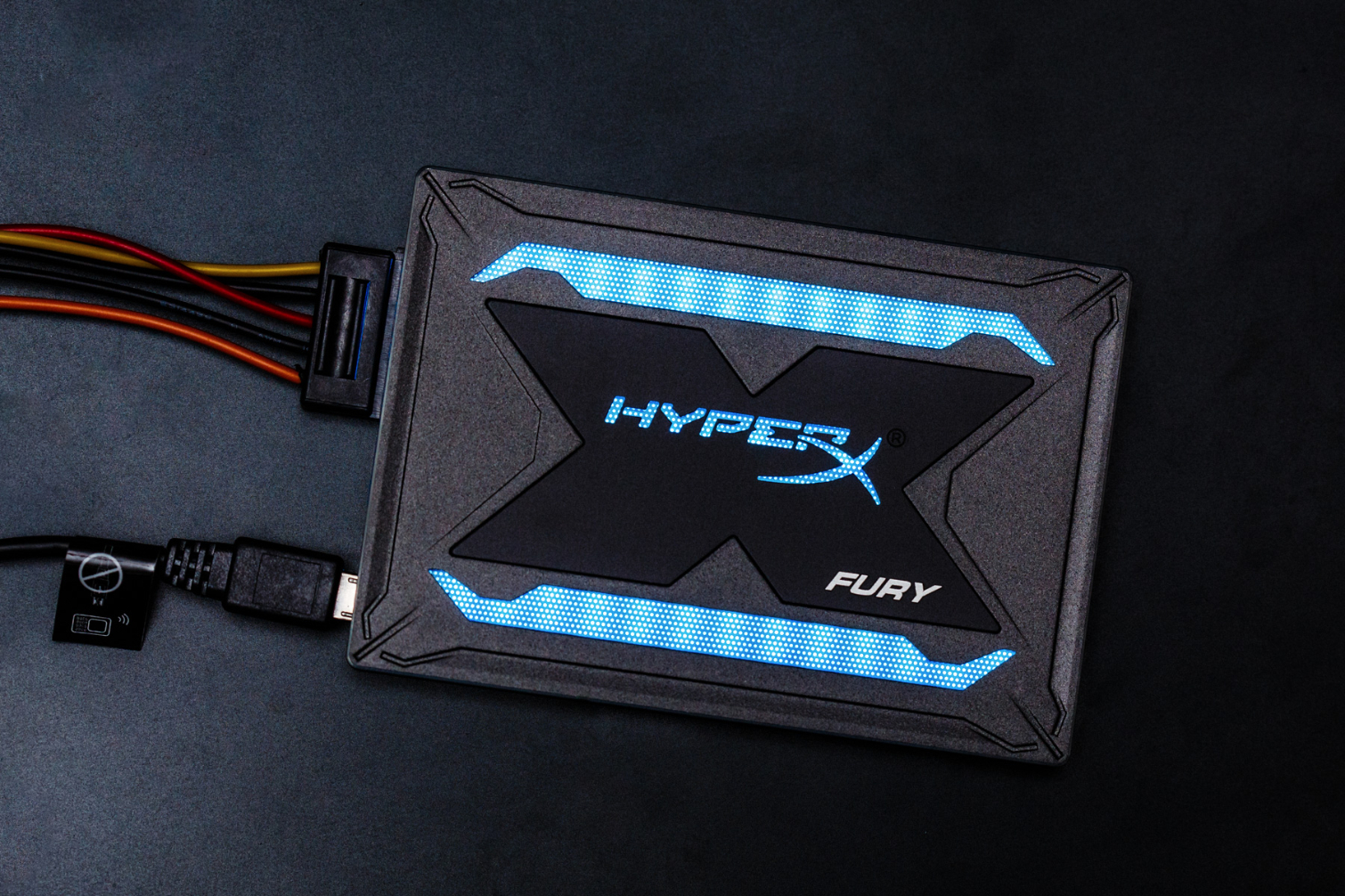Tom's Hardware Verdict
RGB is all the rage these days and HyperX’s new Fury RGB looks amazing, but its performance just isn’t up to par. With so many impressive SSDs to choose from, we don't recommend the Fury RGB unless you are searching for the RGB aesthetics alone.
Pros
- +
Sleek aesthetics with RGB goodness
- +
Sequential throughput
- +
Optional upgrade kit
- +
Free cloning software
Cons
- -
RGB comes with a premium price
- -
Lackluster performance
- -
Poor performance after moderate write and copy workloads
- -
Poor power efficiency
Why you can trust Tom's Hardware
A Colorful Fury, Or Just a Small Flurry?
RGB is all the rage lately. From peripherals like keyboards and mice to primary components like RAM and motherboards, it's RGB everything. RGB is so pervasive we knew it was only a matter of time before it lit up mainstream SSDs, too. Today, we take a look at Kingston’s latest creation from the company's high-performance HyperX division, the Fury RGB SSD.
The HyperX Fury RGB comes resplendent with a fully-controllable RGB light show and boasts up to 550/480 MB/s of sequential read/write throughput. But while the performance may seem impressive on paper, the specs don’t tell the entire story. Our testing found lackluster performance in real-world file transfers and productivity applications. Adding in a paltry three-year warranty and high pricing makes the drive hard to recommend, though some will probably find the shimmering RGB goodness too much to resist.
HyperX is a division of Kingston Technology that claims to use best-in-class components to deliver the highest performance to gamers and enthusiasts. Kingston first developed the brand back in 2002 to differentiate its standard memory products from those that were a notch above, and later expanded its portfolio in 2011 with the company's first SSD.
At the time, just having an SSD meant you had one of the highest-performing storage products available, but times have changed as the SSD market has become more competitive. Since then, there have also been quite a few SSDs under the HyperX name and the product line has stratified into three classes.
Kingston launched the HyperX Fury line in 2014 as an entry-level cost-competitive SSD for the gamer crowd, but it's the lowest step on the ladder. The HyperX Savage comes in a step above for the mainstream crowd, and the Predator line is HyperX's top-of-the-stack enthusiast-class SSD. The Predator was also the fastest PCIe SSD on the market when it originally launched, too.





It's been almost four years since Kingston released a Fury SSD, so it’s overdue for an update. The Fury RGB has an attractive design that matches other HyperX gear, and it features controllable RGB lighting that is a nice addition to the value-minded product line. Seventy-five LEDs shine through two slits on the top of the case and the HyperX logo.
The Fury RGB comes equipped with a newer Marvell 88SS1074 controller, a nice step forward from its predecessors' SandForce 2281, and 64-layer BiCS3 TLC flash. The new HyperX Fury RGB has a whole lot of lighting bling, but the controller and flash pairing doesn't provide the grunt power to back it up.
Get Tom's Hardware's best news and in-depth reviews, straight to your inbox.
Specifications
| Product | Fury RGB 240GB | Fury RGB 480GB | Fury RGB 960GB |
| Pricing | $74.99 | $124.99 | $219.99 |
| Capacity (User / Raw) | 240GB / 256GB | 480GB / 512GB | 960GB / 1024GB |
| Form Factor | 2.5" 9.5mm | 2.5" 9.5mm | 2.5" 9.5mm |
| Interface / Protocol | SATA 6.0 Gb/s / AHCI | SATA 6.0 Gb/s / AHCI | SATA 6.0 Gb/s / AHCI |
| Controller | Marvell 88SS1074 | Marvell 88SS1074 | Marvell 88SS1074 |
| DRAM | ? | ? | ? |
| NAND Flash | 3D TLC | 3D TLC | 3D TLC |
| Sequential Read | 550 MB/s | 550 MB/s | 550 MB/s |
| Sequential Write | 480 MB/s | 480 MB/s | 480 MB/s |
| Random Read | N/A | N/A | N/A |
| Random Write | N/A | N/A | N/A |
| Encryption | N/A | N/A | N/A |
| Endurance | 120 TBW | 240 TBW | 480 TBW |
| Part Number | SHFR200/240G; Upgrade Kit: SHFR200B/240G | SHFR200/480G; Upgrade Kit: SHFR200B/480G | SHFR200/960G; Upgrade Kit: SHFR200B/960G |
| Warranty | 3-Years | 3-Years | 3-Years |
The Kingston HyperX Fury RGB is a SATA 6Gb/s SSD that comes in the 2.5” form factor with a 9.5mm Z-height (thickness). That's slightly thicker than most SATA SSDs, which tend to come in a 7mm-thick case. The extra thickness comes as a byproduct of the extra diffusion layer for the lighting apparatus.
The SSD comes in 240GB, 480GB, and 960GB models that are all rated for up to 550/480 MB/s of sequential read/write throughput. Kingston hasn't shared the Fury's random performance specifications yet, but we put them to the test on the following page. Prices weigh in at $74.99, $124.99, and $219.99, respectively. Kingston provides an Acronis True Image HD software activation key so you can clone your existing drive to the new one. You can also spend $15 more for an upgrade kit that includes a USB 3.0 enclosure, 3.5” bracket, mounting screws, and a SATA data cable.
| Endurance | Fury RGB 240GB | Fury RGB 480GB | Fury RGB 960GB |
| Terabytes Written (TBW) | 120 | 240 | 480 |
HyperX’s Fury RGB comes with a three-year warranty and free technical support, but like most SSDs, it also comes with a write endurance restriction (listed above). The Fury has more endurance than the WD Blue 3D SSD and Crucial MX500, but less than the Samsung 860 EVO.
A Closer Look








You'll need a 12V RGB compatible motherboard or lighting controller to control the SSDs' lighting. Kingston lists compatibility with popular software suites, like Asus Aura Sync, Gigabyte RGB Fusion, MSI Mystic Light Sync, and ASRock's Sync.
The 75 LEDs, which you can see distributed on the back of the PCB, default to red if you do not have a controller or compatible motherboard. The RGB cable is nearly 32", which is long enough to allow for almost any mounting option. Like the SATA power cable, the LED cable can provide power to the lights when connected. You can also daisy-chain the SSD with other RGB devices to match up the colors.
The added lighting effects and all-metal case add some heft to the drive: The Fury RGB weighs in at 165 grams, which is roughly three times heavier than most other 2.5” SATA SSDs.
The drive comes with a Marvell 88SS1074 SATA 6Gb/s controller and a DRAM chip. HyperX paired the four-channel Marvell controller with Kingston-branded BiCS3 64-layer 3D TLC flash. That's a familiar combination: The WD Blue 3D and SanDisk Ultra 3D SSDs come with the same components. Once formatted, our 480GB review sample exposes 446GB of usable capacity to the user.
MORE: Best SSDs
MORE: How We Test HDDs And SSDs
MORE: All SSD Content

Sean is a Contributing Editor at Tom’s Hardware US, covering storage hardware.
-
antonysg77 This RGB bling is just going overboard. I would rather buy a more power-efficient drive or one with a few more additional Gb instead of this fancy drive.Reply -
xxxlun4icexxx While it's interesting. Are people ever going to even see the RGB? Drives are usually on a tray hidden away.Reply -
ATI9800Pro ARE GEE BEEEE ! : https://youtu.be/dnxfOnAU0EY?t=180Reply
Obviously, an all-RGB Kingston/HyperX PC trumps everything ! -
johnrob 'RGB is so dumb, I just HATE options and I think computers should all be beige and have crayon box interior wiring straight from the PSU.Reply
Bring me back blue or green PCBS damnit I miss floppy drives Wahhhhhhhhh.'
Kudos to hyper x, this looks sharp, and every new RGB product helps drive the cost down.